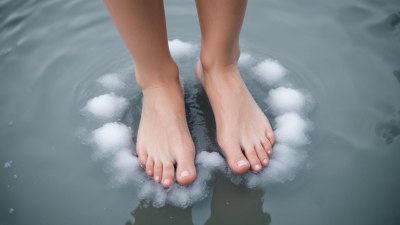The Scientific Mystery of Why Your Feet Freeze in the Water While Your Face Sweats
Explore the science behind why your feet freeze in water while your face sweats. Uncover the mechanisms of temperature regulation.

This image was created with the assistance of Freepik
Have you ever jumped into a cold body of water and noticed how your feet seem to freeze instantly, while your face is sweating? This intriguing phenomenon raises questions about human physiology and temperature regulation. Our bodies are complex systems that respond in various ways to environmental conditions, and understanding why this happens can reveal some fascinating insights about our biology.
The Basics of Human Thermoregulation
The human body maintains a core temperature of around 98.6 degrees Fahrenheit (37 degrees Celsius). To achieve this, it employs a process called thermoregulation, which involves various systems and mechanisms to regulate heat production and loss. When we are exposed to cold water, our bodies respond by conserving heat, particularly in the extremities, which includes our feet.
In contrast, when we experience heat, our bodies cool down through sweat evaporation. Sweat glands are concentrated on our faces, palms, and soles of the feet, but their primary purpose is to regulate body temperature. The differences in how our body parts respond to temperature changes can help explain why some areas feel colder than others when exposed to water.
The Role of Blood Flow
One significant factor that contributes to our experience of cold feet versus a sweating face is blood flow regulation. When our feet are submerged in cold water, our body responds by constricting blood vessels in that area to preserve core body heat. This constriction reduces blood flow, which means less warmth is delivered to the feet, making them feel even colder.
On the contrary, when we are hot and our face is exposed to warm or humid conditions, the opposite occurs. Blood vessels dilate in response to heat, allowing more blood to flow to the surface of the skin, where it can release heat into the environment. This increase in blood flow also stimulates the sweat glands, leading to perspiration on our face.
The Importance of Extremities
Human anatomy prioritizes the core's temperature regulation over the extremities. The hands and feet are more exposed to cold conditions, and while they also have sweat glands, the body tends to redirect resources to maintain the temperature of vital organs in the torso. This approach helps ensure that essential systems such as the heart and lungs have a stable environment to function optimally. The brain, often referred to as the body's control center, prioritizes maintaining core body temperature, leaving the extremities more susceptible to cold.
Nerve Response and Temperature Sensation
The sensations we feel in response to temperature changes are rooted in the nervous system. Specific receptors in our skin detect temperature changes, sending signals to the brain about our environment. Cold receptors become active in cold conditions, while warm receptors do so in heat. The response of these receptors can lead to a disconnect between how you perceive different body parts at various temperatures. For example, even if your core temperature stays stable, cold water can lead to significantly colder perceptions in your feet compared to other body parts.
The Influence of Water Temperature
The temperature of the water can also play a vital role in how we perceive cold in our feet versus heat on our face. Water conducts heat away from the body much more efficiently than air. This means that cold water can draw heat away from the body at a faster rate than cold air, resulting in an even more pronounced cold sensation in our feet. Conversely, our face, which often has a greater surface area exposed to air, can become sweaty more quickly due to the combination of heat generation and efficient evaporation of sweat.
The Impact of Hydration Levels
Dehydration can also affect how our body regulates temperature. When the body lacks sufficient fluids, it can struggle to maintain sweat production effectively. This can exacerbate the feeling of sweating in some areas while our extremities become cold and unresponsive. Ensure proper hydration when outdoors or when anticipating changes in temperature or activity level, particularly if swimming in cold water. Hydration allows the body to efficiently modulate temperature through sweating and can help maintain blood volume, impacting how well blood circulates to our extremities.
Acclimatization and Individual Differences
Individual differences can also play a significant role in thermal sensation in different body parts. Factors such as age, fitness level, and even acclimatization to temperature extremes can influence how you feel during exposure to cold water or hot conditions. For instance, someone who frequently swims in cold water may have adapted to this environment, experiencing less drastic sensations than someone unaccustomed to cold temperatures.
Moreover, physical fitness can influence blood circulation, affecting how the body allocates warmth and cold to various areas. Athletes often have improved blood flow and temperature regulation, which can lessen the extremes of cold in the feet while improving heat dissipation through sweating.
The Psychological Component of Temperature Perception
Interestingly, the psychological aspect of temperature perception cannot be overlooked. Cultural and personal experiences can shape how we respond to environmental stimuli. For instance, if someone has a fear of cold water, they might experience heightened sensitivity in their feet compared to someone who views it as a pleasurable experience. Similarly, past experiences with sweating might shape how we react when dealing with temperatures in different body parts.
The Complexity of Temperature Regulation
In summary, the feelings of freezing feet in cold water and a sweating face when exposed to heat stem from your body's complex temperature regulation systems. Blood flow, nerve responses, water temperature, hydration levels, individual differences, and psychological components all contribute to how we perceive temperature in various body parts. Understanding these mechanisms not only sheds light on an everyday experience but also highlights the sophistication of the human body in adapting to environmental challenges.
So, the next time you find yourself diving into chilly waters, take a moment to appreciate the incredible mechanisms at play within your body. It’s a testament to the fantastic adaptability and the intricate systems that allow us to thrive despite the extremes of nature.











